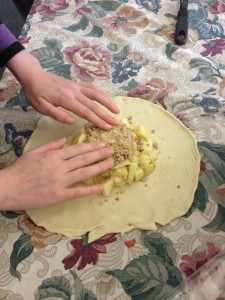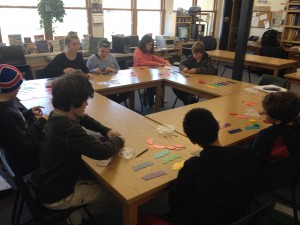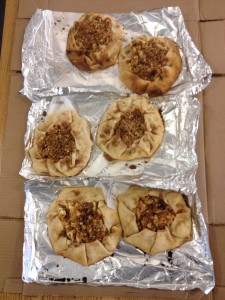It wasn’t easy to fit all of our goals for circle-related math into this week because of so many other things that we did, so we are going to continue the topic when we return from Spring Break on March 31. We’ll start with some review before we move forward. The important learning that this topic includes is the use of formulae. For some students, this was familiar ground, but others were new to it and/or were challenged by the need to understand the relationships among the variables so they could plug numbers into the right places.
The big component of this was understanding the meaning of pi. We’ve had a very long poster on our wall over the windows all year, and students have sometimes talked about it, but this was the week we dug in. Pi expresses the ratio of the circumference of a circle to its diameter. That is, the ratio of C to D is pi to 1. Why use a Greek letter? Because it is an irrational number. It is approximately 3, but — more accurately — it’s a non-repeating decimal that never ends. Through the week, we used 3 and also 3.14 as approximations. We wanted students to have not only a name (“pi”) but also a numerical value that they could internalize and use for estimates and problem-analysis. We began by measuring the circumference and diameter of lots of stuff in the room — jars, plates, stools, rolls of masking tape, round magnets, cups, and more. After they had a collection of data, they did the division: C divided by D. Although their answers varied from item to item, the general result was a bit more than 3. We agreed that it was much easier to measure the diameter than the circumference. We talked about one of the uses of pi — to give us a way to find the circumference or the diameter without needing to measure both. On Friday, we used Geometer’s Sketchpad on our computers to create a circle, measure its circumference and diameter, divide C by D (to 5 decimal places), and then drag the circle bigger and smaller to see what changed and what stayed constant. As students expected, although the numbers for C and D changed, the quotient remained the same — approximately pi.
We then moved on to analyzing the formula for finding the area of a circle (you remember — pi times the square of the radius). We worked with fraction pieces to see how a circle could be partitioned into smaller and smaller slices which would then be arranged into a parallelogram. We reviewed the area formulae for rectangles and parallelograms on the way to “discovering” the circle area formula. On the next day, we watched a short, humorous video that presented the same visual rationale for the area formula in a slightly different way. We encourage you to watch it if you want to see our evolving process in action.

Essentially, when the slices are arranged in an imaginary parallelogram (imaginary because it requires an infinite number of tiny slices), the height is equal to the radius of the circle and the base is equal to half of the circumference. So the area = the radius times C/2. But we’d like to avoid having to measure the circumference because it’s difficult. We know that the circumference is equal to pi times the diameter. That means half the circumference equals pi times half of the diameter. Half of the diameter is the radius. So now we have area = pi times the radius times the radius, or pi * the radius squared. And that’s the customary form of the formula!
On Thursday we made 18 small apple pies in honor of Pi Day on Friday. (The connection with pi??? Well, they ARE round, and math was involved in dividing the apples as well as the pies. Several children found apple peeling to be quite a challenge, but everyone got it done.) We made enough to share with the 5th graders. One of our group suggested sharing with bridge-building partners, and that’s what we did.


Agents of Change was the companion activity to the conference 10 of our group attended with Mark and Jeri on Tuesday. While our travelers to the Haverford School were meeting students from more than 20 other middle schools and learning about social activism, those of us who stayed at school chose and researched a number of social activists from past and present. We deliberately offered a list of people that students were unlikely to know already. The focus issues and goals of the chosen activists’ efforts included Native American rights, care of the mentally ill, women’s rights, child labor, saving Jews from the Nazis, Asian-American civil rights, raising awareness of deep poverty in America, rights and care of the sick (especially the poor and socially exiled), rights for the elderly, Black civil rights, care of war orphans in Rwanda, and more. The people about whom students created presentations were: Jacob Riis, Father Damien, Dorothea Dix, Anna Mae Aquash, Alex Scott, Ryan White, Joan Trumpauer-Mulholland, Maggie Kuhn, Anne Heyman, Moira Kelly, Richard Masato Aoki, Iqbal Masih, Claudette Colvin, Oskar Schindler, Mother Theresa, and Susan B. Anthony. There were connections among some of them — Moira Kelly was inspired by Mother Theresa, for example. And there were some baffling associations that needed explanation — after learning a bit about the Black Panthers, students heard about Maggie Kuhn of the Grey Panthers. That took a little time to straighten out!
We asked students to try to find out if the people they selected had always (or ever) worked peacefully, if they had paid a price for their activism, and if they had been successful in their work. Students were encouraged to look for a quote from their subject as well as any criticism of their goals and outcomes. One of the things students realized (we hope) as they made their presentations is that they should never present information they don’t understand — they need to ask about the meaning of unfamiliar words, the location of cities and countries, the references to events that were connected to their topic. And they need to know how to pronounce all the words when they read their text aloud. This is a gradual process, of course, but we hope that most students will be much more clear about those responsibilities by the end of the year.
On Thursday, we got the whole class together to hear about the conference and to start sharing the research presentations, which finished up on Friday. It was a very meaningful part of our week that we expect to extend its influence far into our children’s futures.
We wrapped up our Life Skills 101 project. Students printed out their journals and worked with a partner to explain each other’s goals and how it went. Many students worked on cooking in some form, mostly preparing meals for their families, but there were other projects as well, including dish-washing, laundry, dog walking, and grocery shopping. Some expressed interest in continuing their work beyond our classroom culmination. All acknowledged that what they were doing was usually done by their parents. We hope they at least have a new-found appreciation of that parental support, even if they can’t wait to hand the jobs back to them again!



